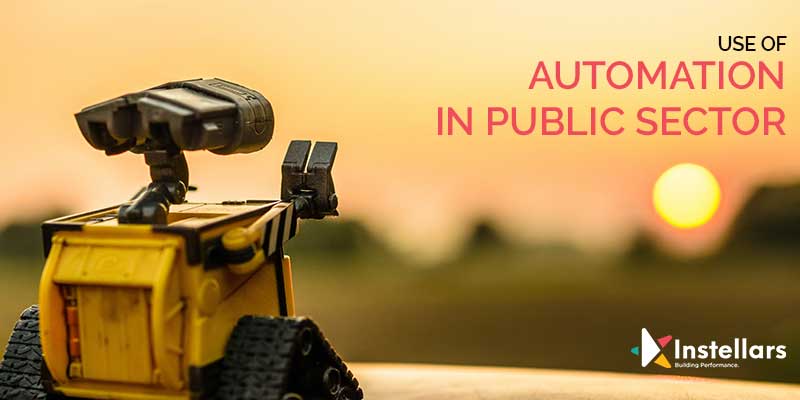
Use of Automation in Public Sector

Intelligent automation provides immediate and effective solutions to public sector organisations, which helps them optimise their cost and time. Using Robotic Process Automation (RPA) and Artificial Intelligence (AI) in the public sector will get the organisations ready to transform digitally.
1) Using RPA to Circulate Data With all Public Agencies
In order to come up with an effective response to a crisis, it is essential that public sector companies come together, collaborate and work towards arriving at a solution. AI-powered RPA bots are capable of helping organisations in building a picture on the ground reality when the regular way of assessing is not working.
For instance, with the right use of AI and RPAs, public healthcare department can capture the data regarding the health of the public through a self-reporting mechanism, which requires individuals to self-assess their health by reading a questionnaire and filling a form.
Here are a few examples of what intelligent automation can do to support the healthcare department:
● Gathering information regarding the oversea travel of individuals and their health condition through self-assessment.
● Verify the precision of the data available and as well as its completeness.
● Process relentless trigger prompts and updates for the healthcare department and suggesting the probable solutions depending on the situation.
Here’s how RPAs are helping the healthcare department during the ongoing COVID-19
pandemic:
● Screening centre: This is the screen on which the individuals are required to input their details, and will be recorded by the bots. If they have come down for an examination, the authorised personnel will input the information on the screening centre.
● Bot navigation and extraction: The bots deployed in the operation will extract the required information from the testing helpline.
● Bot lookup: The bots will check if the individual whose data is being assessed has travelled abroad in recent time. An example could be checking for the individual’s name on the ticketing portal of all international airlines.
● The bot does its work: The bots under operation will input the individual’s health information into a communication channel and share the same with the concerned departments.
● Bots raise a concern: If the information discovered by the bots calls for the individuals to undergo in-person health check-up, he or she would be alerted of the same.
2) Reporting of the Utilisation of Emergency Funds
If the organisations are to receive emergency funding, they need to furnish accurate data and timely reporting of the status of their finances to the agencies. This process is simplified to a greater extent by RPAs. Bots will be of great help in developing the reports in the prescribed manner and dispatching the same to the concerned departments and agencies for their records.
Here’s how AI can help:
● Gather the expense by reporting data from various channels including services availed, products purchased, date of expenditure, and so on.
● Verify the information available and ensure its completeness.
● Maintaining a clear demarcation between the baseline finances and emergency funds.
3) Providing Contemporary Information to the Public
The healthcare department can make use of the bots to relentlessly gather, monitor, and keep up-to-date with information and communicate the same to the citizens. When there is a major crisis such as the ongoing one induced by the novel coronavirus, the public more often than not would seek to follow the data and guidelines being released by the government.
For instance, if you are to know the quarantine guidelines, the number of new and active cases, quarantine zones, and so on, the most reliable source is the government. To facilitate smooth reporting of numbers to the public, the AI is engineered in such a way that it functions 24/7. It is capable of sourcing and consolidating data, and communicating the data accurately to the public.
It collects data from several sources. It covers information regarding the availability of medicines, gloves, masks, PPE kits, sanitiser, and so on in the inventories. It also helps individuals in locating the test centres, informing the individuals undergoing a test with their result, and scheduling appointments with doctors and counsellors.
Here’s how RPAs can help the health department:
● Gather data from healthcare facilities: The bots in the system can gather information from hospitals, clinics, stores, and pass on the same to government organisations.
● Data validation: The bots will ensure if the submitter of the data is authorised to provide the data and if it is accurate. The bots will also inform the submitter if any data is missing.
● Transmission of data: The bots in operation can transmit the data and create an interactive map.
● Capturing feedback: This section helps individuals to access map and allows them to provide feedback on the sections they are interested to see.
● Prioritisation of request servicing: The bots under operation will receive requests from the users and categorise them based on their type and priority. This helps the authorities in taking up the tasks depending on their priority.
Conclusion
These are some of the ways in which AI and RPAs are empowering public sector companies in servicing the public better. The implementation of the latest technology will help them in streamlining their operations and makes life easy for the authorities.
The transformation that matters
Send your resume to Careers @ Instellars
